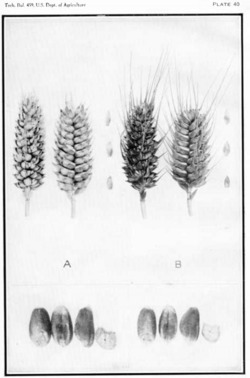Triticum compactum erinaceum facts for kids
Quick facts for kids Triticum compactum erinaceum |
|
|---|---|
 |
|
| Triticum compactum humboldtii (A) and Triticum compactum erinaceum (B). Kernels at x3 magnification. | |
| Scientific classification | |
| Kingdom: | |
| (unranked): | |
| (unranked): | |
| (unranked): | |
| Order: | |
| Family: | |
| Subfamily: |
Pooideae
|
| Tribe: | |
| Genus: | |
| Species: | |
| Subspecies: |
T. compactum erinaceum
|
| Binomial name | |
| Triticum compactum erinaceum Davis
|
|
Triticum compactum erinaceum, also known as California Club Wheat or Mayview wheat, is a type of wheat that is now extinct. It was a subspecies of a larger group called Triticum compactum, which is a hexaploid club wheat. This means it had six sets of chromosomes, making it a very strong and adaptable plant.
This special wheat was known for its unique look. It had a "beard" (long bristles), a hairy stem part called a rachis, and reddish husks (chaff). People even thought it looked a bit like a hedgehog! It was believed to have disappeared a long time ago, even before the year 1822.
However, some exciting news came much later! The United States Department of Agriculture found two more samples of this wheat. These samples showed that T. compactum erinaceum was still growing in the United States until the time of the Dust Bowl. The Dust Bowl was a period in the 1930s when severe dust storms damaged farms across the country. After that, this wheat likely disappeared for good. Only four samples of T. compactum erinaceum have ever been recorded.
What Did This Wheat Look Like?
T. compactum erinaceum had some distinct features that helped people identify it.
- Brush: It had a small, short "brush" at the end of its kernels.
- Stem: The stem was usually white, but sometimes had a faint purple color on the lower parts.
- Spikes: It had spikes (the part that holds the grains) that were 2 to 5 centimeters long and had awns (bristles).
- Glume: The glume, which is the protective covering around the grain, was brown, wide, and smooth.
- Shoulders and Beaks: The glume usually had rounded shoulders and wide, curved "beaks" that were 1 to 4 millimeters long.
- Kernels: The kernels (the actual grains) were red, short, soft, and oval-shaped. They were also a bit humped and curved.
- Germ and Crease: The germ (the part that sprouts) was small. The crease (a groove on the kernel) was medium to wide and not very deep.
- Cheeks: The sides of the kernels, called cheeks, were usually angular.
A Brief History of This Wheat
T. compactum erinaceum has an interesting story of being lost and then found again.
- Early Growth: In the late 1700s, Jesuit Monks grew this wheat along with other types in Monterey County, California.
- Thought to be Lost: After 1822, people thought T. compactum erinaceum had become extinct.
- Rediscovery in Washington: But in the summer of 1917, a person named E. F. Gaines found it growing again! He was from the Washington Agricultural Experiment Station and found it near May View, Washington.
- Found Again in Oregon: Then, in 1929, it was reported to be growing in Douglas County, Oregon, on a large area of 322 acres.

